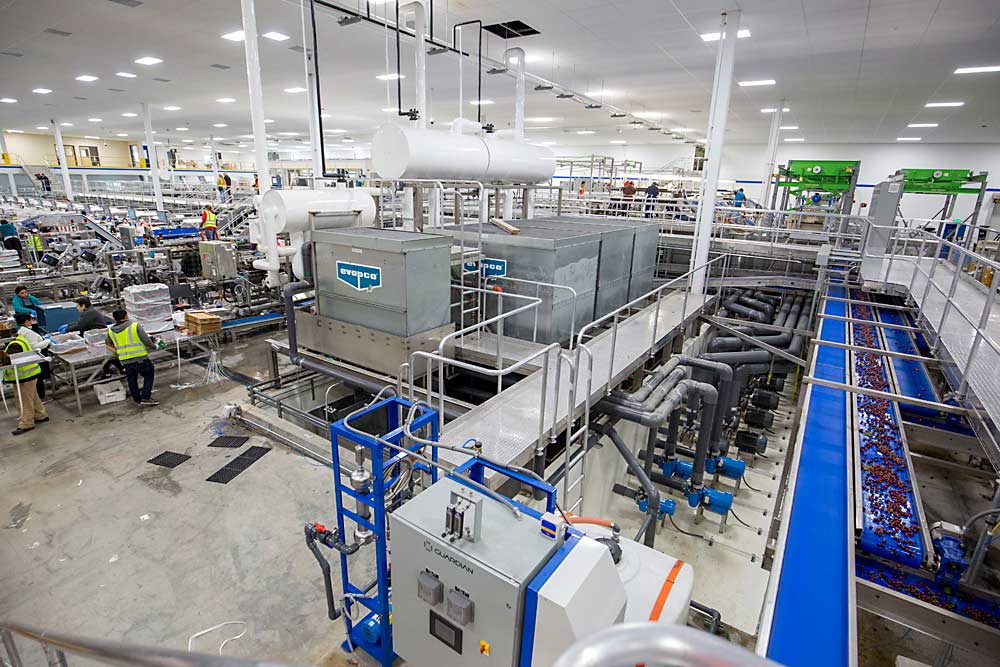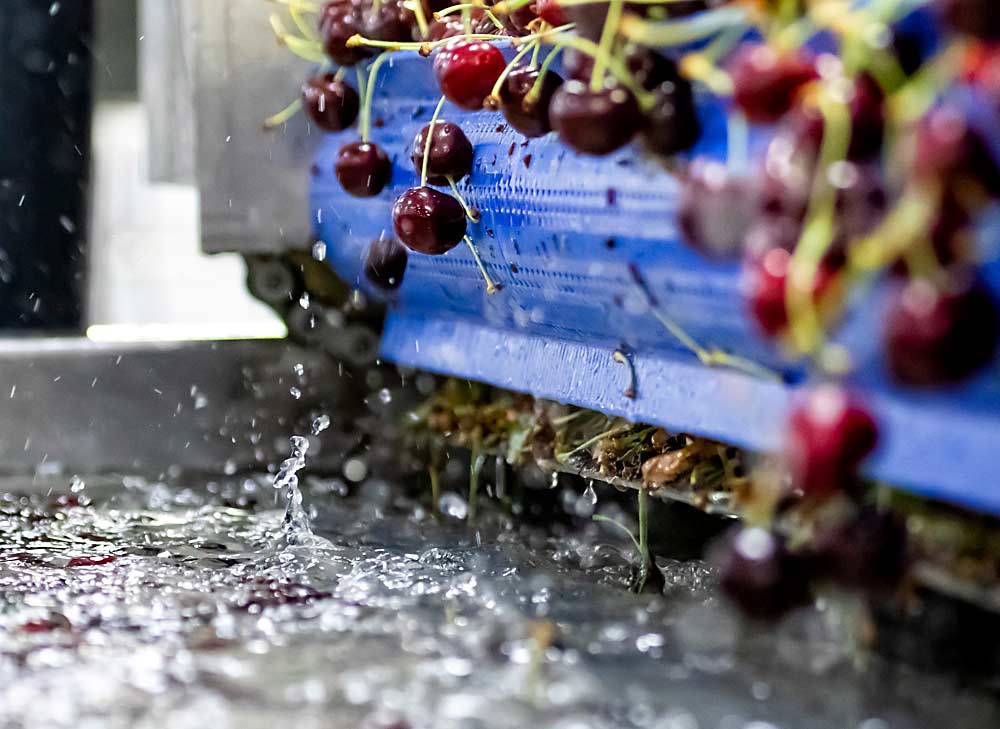
Ozone is booming.
Although packers have been burned in the past by ozone — literally — adoption of the technology is on the rise due to its use in organic apple storage and the desire to ensure food safety while reducing chemical residues or costs, said Faith Critzer, the food safety extension educator at Washington State University.
“It’s an effective antimicrobial that’s active against our foodborne pathogens and decay organisms like molds and yeasts. It can be applied at any step of the process,” she said in a talk on the pros and cons of ozone at Washington State University’s Postharvest Fruit School last year. “It physically attacks the lipids that make up the cell walls and the pathogen cells have burst open, so you are not going to get survival after treatment.”
Today, suppliers offer ozone systems for controlled-atmosphere (CA) storage, aqueous application on the packing line, and sanitation systems for storerooms, packing lines and equipment, along with sensors and monitoring programs that aim to prevent the application mishaps that have made some people wary of ozone.
“We’re experiencing a new stage of acceptance in the industry,” said David McGrath, vice president of marketing for Guardian Ozone, an ozone supplier based in Florida. Nearly a third of the CA rooms in Washington now include ozone technology, he estimated, and there’s a growing market for cherry and pome fruit packing line systems.
“Ozone does its job and reverts back to oxygen so there’s no residual. That’s what the consumer wants,” McGrath said.
While the basic technology — using electricity to split oxygen molecules to generate highly oxidizing ozone — has been around for more than a century, the science and engineering to use ozone for fruit treatment safely, consistently and effectively is finally catching up to the promise, McGrath said.
“Ozone is easy to make; what is difficult is to get and keep the concentrations accurate,” he said. “It’s about the application engineering.”
In the gas form, ozone can damage fruit if the concentration gets too high, and in the aqueous form, higher concentrations can result in off-gassing that can pose a health risk to workers, so it’s important to have thorough monitoring and ventilation.
Though interest in the technology’s benefits — organic, no residue, no chemical bills — is booming, it’s important to remember the drawbacks and limitations, said Trevor Suslow, vice president of food safety for the Produce Marketing Association.
“If you are dedicated to using ozone as a sanitizer for food safety, you have to build the whole system around it. You can’t just buy an ozone generator to push it into water or into a cold room,” he said. “I’m not trying to cast a big dark cloud over the ozone technology industry. The responsible ones walk clients through the technical needs to use it well, while others rely on the hype without the effective support.”
Storing
After first testing ozone in two storage rooms about a decade ago, Gebbers Farms, in Brewster, Washington, now has more than 150 rooms under ozone, plant engineer Richard Thomason said at Washington State University’s Postharvest Fruit School.
“Different varieties need different treatments, but there are never pockets of decay in the bins. If you have an apple with a puncture, it decays, but nothing decays around with it,” Thomason said. “Consistently, we get one to three more packs per bin with ozone.”
Suppliers are hesitant to make promises of increased packout, McGrath said, since so many variables go into each orchard’s performance each season. Nick Lyon, tree fruit sales representative for the TriStrata Group, a nonchemical food safety company based in Washington state, agreed.
“Same lot fruit, same year, picked at the same time, same everything, we can split and store in two different rooms and one year we’ll see a significant increase in packout in the ozone room, and we’ll do the same thing with the same customer the following year and not see any difference,” Lyon said.
The measurable benefits come from pathogen reduction, Lyon and McGrath said.
Recent research by Washington State University scientists backs this up. Pathologist Achour Amiri and microbiologist Meijun Zhu teamed up to look at the effects of season-long ozone on both decay pathogens and human pathogens in a project funded by the Washington Tree Fruit Research Commission.
“We found that it may not be very good in controlling fungus if you have a flesh wound at harvest, but it can kill the spores on the fruit and reduce the spore load,” stopping what’s called nesting, Amiri said. That supports Thomason’s observations. Ozone levels of 70 to 80 parts per billion can control that nesting effect and show no degrading impact to the chemical fungicides conventional growers and packers may want to use in conjunction with ozone.
Those storage conditions also reduced populations of Listeria innocua — a benign bacteria that’s closely related to the pathogen Listeria monocytogenes and used as a proxy in food safety research studies — 100-fold more than just CA storage does. That 99.99 percent reduction is significant, but it’s not a guarantee.
“If you are doing it to reduce microbial contamination, it’s never going to be 100 percent,” Suslow said. “It fits within a risk-reduction, multiple-hurdle approach.”
Suslow added that some of the lab studies demonstrating its effectiveness on foodborne pathogens may be overpredicting the benefits, simply based on the difficulty of conducting these sorts of studies.
Reducing the pathogen load in storage may also help to prevent contamination on the packing line.
“From a food safety perspective, the benefit is probably greatest on the front end of the system because it’s reducing the population of listeria coming in to the facility,” said Jon Brandt, co-founder of Ozone International and now the chief commercial operator for TriStrata Group, which acquired Ozone International’s assets in 2017.
“There’s more benefit in storage, which is why you see more adoption there, but since storage is in this closed-off room with no light and no oxygen and no access, there is more risk than you would see in a packing line application,” Brandt said.
The risk of fruit damage from gaseous ozone in storage occurs when fruit is overexposed, which can happen if sensors break or poor circulation in the room results in pockets of higher ozone concentration. Suppliers say new technologies lower this risk, but significant losses have still occurred in Washington in recent seasons.
“Cold storage designers all say they have good airflow, but in fact, there’s a lot of variability,” Brandt said, adding that TriStrata now monitors airflow in storerooms to ensure the ozone is being administered appropriately. “Airflow readings give us and (our customers) that level of confidence so they can confidently administer ozone. It’s important for us, it’s important for them, and it’s important to the insurance community that’s underwriting this fruit.”

Packing
In 2015, Blue Bird Inc. built a cherry line designed to rely on ozone in the final bath rinse, as the pathogen-reduction step, at its Wenatchee, Washington, warehouse, said company President Ron Gonsalves. The company also uses ozone as a fruit rinse on its conventional pears and on its organic apple line, as well as in organic apple storage.
“Packing as much organic as we pack, we felt it was a good alternative to provide us that confidence that we were getting the fruit treatment,” he said of the cherry line. “It helps us reduce concerns about (maximum residue levels) on exports as well.”
Other packers use aqueous ozone in conjunction with other sanitizers. Stemilt Growers in Wenatchee employs aqueous ozone in the final rinse on two apple lines, while a chlorine sanitizer is used in the secondary flume, said Rob Blakey, Stemilt’s research and development manager. Those systems were retrofitted with ozone, but it’s been effective enough that the technology is being considered for future lines, he said.
While ozone technology can be retrofitted into older packing lines, it can be tricky to engineer the system so that the fruit gets exposed to enough ozone, McGrath said, such as if the brush bed is too short for the necessary exposure time.
Success occurs when the right concentration of ozone is applied to the fruit or fruit wash water for the right amount of time. Longer exposures — such as a minute in a secondary flume — require much lower concentrations than 10 or 15 seconds of spray treatment on a brush bed.
Depending on the situation, sometimes ozone can be the only food safety treatment on a line, and sometimes it’s best used in concert with chemicals, McGrath said. “Chemistry is not the competition,” he said. “We’re all working to the same goal of safer fruit.”
Looking ahead
A new application technology being developed by postharvest supplier Decco aims to make it easier to retrofit ozone. It’s the chemical company’s first foray into ozone, driven by demand in the global fruit industry for zero-residue fruit, said Sohail Akhter, the director of research and development for Decco Worldwide, based in California.
Instead of aqueous ozone, Decco’s system sprays ozone gas, surrounded by a spray of water that delivers it to the fruit. This allows a much higher concentration of ozone to be applied, so it can work quite quickly, Akhter said. The technology is in the semi-commercial stage of development, he said, and being used by a handful of fruit packing facilities around the globe, including in Israel and South America and by a citrus packer in California.
More innovative uses are on the horizon.
Amiri said his research shows that high concentrations of ozone for 24 to 48 hours in empty storage rooms may serve as an effective sanitizer, but research into the safety of the system continues. McGrath said that Guardian is developing a secondary flume application for pome fruit that enables packers to use much lower levels of ozone than their Rainbar application. Brandt said that TriStrata is working to better understand airflow in storage rooms.
And Critzer said that as researchers in other fields continue to explore the cutting-edge uses of ozone for sanitation, innovations in, say, the medical field could trickle down to benefit produce packers.
“It will be interesting to see if we move from aqueous to gaseous application in packing operations,” she said. “That’s where the food safety research is going, to get that kill step in fresh produce we’re all looking for.” •
—by Kate Prengaman






Leave A Comment